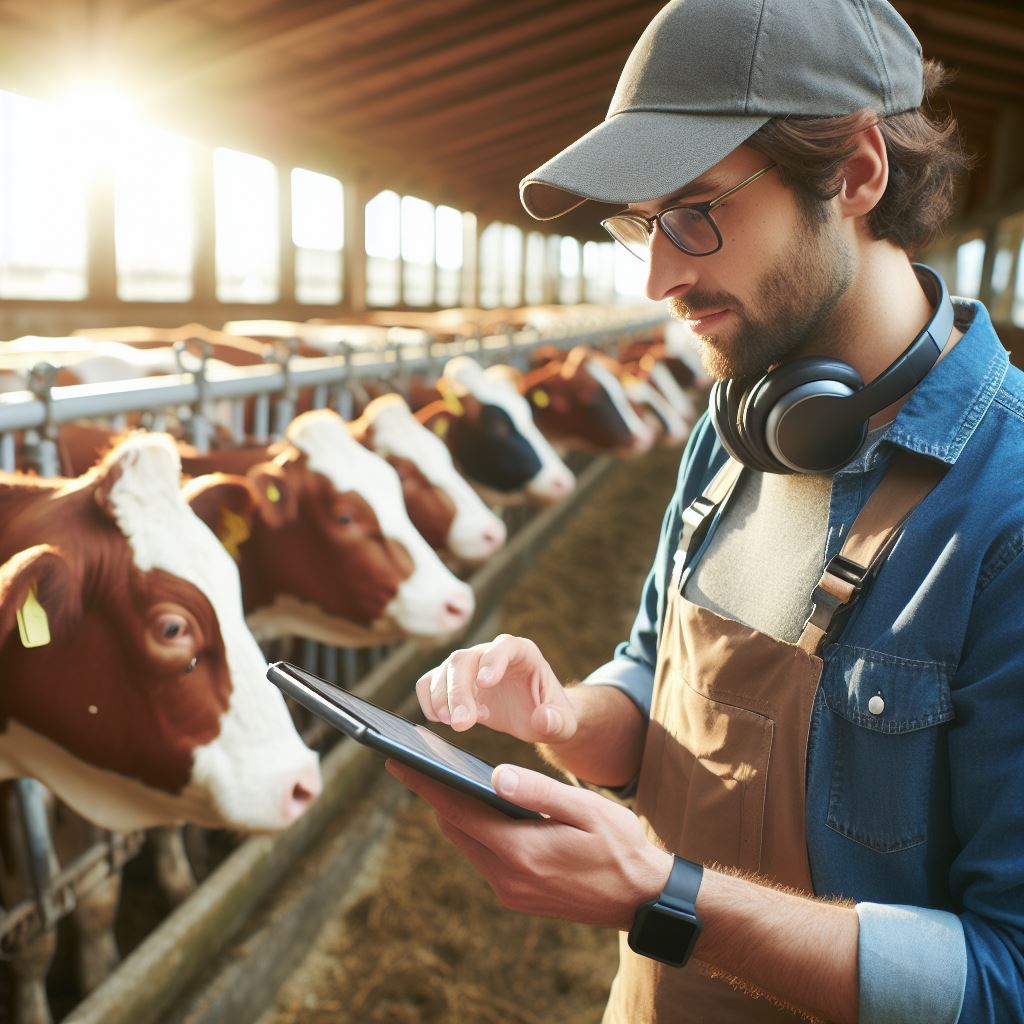Livestock Genetics: Tech-Driven Breeding
Last Updated on January 23, 2024
Introduction
A. Brief explanation of livestock genetics
Livestock genetics tech driven breeding plays a pivotal role in shaping the health, productivity, and sustainability of animal agriculture.
Selective breeding focuses desirable hereditary traits to enhance livestock quality.
As technology progresses, genetic methods are becoming more advanced, scientific and precise.
Superior sires and dams pass advantageous characteristics to offspring like rapid growth, feed efficiency, climate resilience, fertility and milk production.
Propagating these lineages optimizes farms’ outputs and profits.
However, traditional breeding approaches had limitations, relying heavily on pedigree tracking and trial and error.
Modern genomic testing identifies animals’ DNA markers, predicting offspring attributes more accurately.
B. Transition to tech-driven breeding methods
Technologies like artificial insemination, embryo transfer and cloning also enable wider propagation of elite animals.
Computer modeling simulates crossing diverse bloodlines to determine optimal pairing.
Testing and selection is further enhanced by biotech innovations like gene editing.
These technologies allow accurate control over breeding, accelerating livestock improvement.
The following sections will explore specific processes advancing genetics like genomics, gene editing CRISPR and assisted reproductive technology.
Precision breeding techniques are transforming livestock farming, driving the industry’s advancement.
Traditional Breeding Methods
A. Artificial Selection and Selective Breeding
- Artificial selection is the process of selectively breeding animals with desirable traits.
- Selective breeding aims to amplify desired characteristics and eliminate undesired traits.
- Breeders choose specific individuals to reproduce, based on their genetic makeup and physical attributes.
- This method has been used for centuries to improve livestock species for agriculture.
- Artificial selection and selective breeding have resulted in significant improvements in livestock quality.
B. Challenges and Limitations of Traditional Methods
- Traditional breeding methods are time-consuming, requiring multiple generations to achieve desired outcomes.
- Genetic diversity may decline due to limited gene pools and repeated inbreeding.
- Traditional methods may not effectively address complex genetic traits or diseases.
- The reliance on phenotypic selection alone may overlook valuable genetic variations.
- Breeders face difficulties in identifying and selecting for subtle or recessive traits.
- Traditional methods may not keep pace with the increasing demands of a growing population.
C. Need for More Efficient and Effective Breeding Techniques
- Advancements in technology have opened up new possibilities for livestock breeding.
- Modern breeding techniques offer faster, more precise, and targeted genetic improvements.
- Genomic selection allows breeders to identify desirable traits using DNA-based technologies.
- This technique enables early identification of promising animals for breeding programs.
- Genomic selection significantly reduces the time required to achieve desired genetic outcomes.
- Marker-assisted selection helps identify genes associated with specific traits without full genomic sequencing.
- These techniques enhance the accuracy and efficiency of traditional breeding methods.
- Technological advancements enable breeders to address complex genetic challenges, such as disease resistance.
- New tools like CRISPR-Cas9 gene editing offer opportunities for precise genetic modifications.
- Efficient breeding techniques are crucial for ensuring sustainable, resilient, and productive livestock populations.
Generally, traditional breeding methods have played a significant role in improving livestock genetics.
However, they come with limitations in terms of time, precision, and adaptability to complex genetic traits.
The need for more efficient and effective breeding techniques has emerged, driven by advancements in technology.
These modern techniques, such as genomic selection and gene editing, offer faster, targeted, and accurate genetic improvements.
They enable breeders to address challenges related to genetic diversity, disease resistance, and the increasing demands of a growing population.
By combining the best of traditional methods with innovative technologies, livestock genetics can be further enhanced, resulting in sustainable and resilient animal populations for the future.
Read: GPS Tracking: Transforming Herd Management
Role of Technology in Livestock Genetics
A. Introduction of advanced genetic tools
- Advanced genetic tools have revolutionized the field of livestock genetics.
- These tools include genome editing techniques like CRISPR-Cas9.
- CRISPR-Cas9 allows scientists to modify specific genes in livestock embryos.
- Other tools include marker-assisted selection and quantitative trait loci analysis.
- These tools help identify desirable traits and improve breeding programs.
B. Use of genomics and DNA sequencing
- Genomics involves analyzing the entire DNA sequence of an organism.
- DNA sequencing allows scientists to identify genetic variations and understand their impact.
- With genomics, breeders can select animals with specific desirable traits.
- It helps in identifying animals with higher resistance to diseases, better meat quality, or increased milk production.
- Genomic data is used to create breeding values, providing valuable information for genetic selection.
C. Impact of technology on breeding process and genetic selection
- Technology has significantly accelerated the breeding process in livestock genetics.
- Traditionally, selective breeding took several generations to achieve desired traits.
- With advanced tools, breeders can identify and select animals with desired traits at an early stage.
- It reduces the breeding cycle and allows for faster genetic improvement.
- Technology has also enabled breeders to make informed genetic selection decisions.
- They can analyze the genetic potential of individual animals and select the best candidates for breeding.
Overall, technology has transformed the field of livestock genetics by introducing advanced genetic tools, utilizing genomics and DNA sequencing, and improving the breeding process through informed genetic selection.
These advancements have allowed breeders to accelerate the genetic improvement of livestock and achieve desirable traits more efficiently.
Read: Precision Livestock Farming Explained
Benefits of Tech-Driven Breeding
A. Enhanced genetic traits through precision selection
- Livestock genetics, driven by technology, allows for precise selection of desirable genetic traits.
- Breeders can analyze the genomes of animals to identify specific genes responsible for desirable characteristics.
- By selecting animals with these genes, breeders can enhance traits such as milk production, meat quality, or disease resistance.
- This precision breeding leads to a more efficient livestock industry, with animals exhibiting superior traits.
- Enhanced genetic traits result in improved consumer satisfaction, as animals produce higher-quality products.
- The use of technology in breeding enables breeders to accelerate the rate of genetic improvement within their herds.
- Precise selection also minimizes the risk of passing on undesirable traits, ensuring healthier and more productive livestock.
- Breeders can now confidently breed animals with the desired traits, resulting in a more consistent and marketable product.
- Through tech-driven breeding, the livestock industry can meet the increasing demand for higher quality and more sustainable products.
B. Improved animal health and disease resistance
- Tech-driven breeding plays a significant role in improving animal welfare and reducing disease susceptibility.
- Genetic selection can focus on traits related to disease resistance, such as immunity or tolerance to specific pathogens.
- Breeders can identify animals with genetic variations that make them less vulnerable to common diseases.
- By breeding for disease resistance, farmers can reduce the need for antibiotics and other medical interventions.
- Improved animal health not only benefits individual animals but also contributes to the overall biosecurity of a farm.
- With tech-driven breeding, breeders are better equipped to combat emerging or evolving diseases.
- By implementing genomic selection, breeders can identify carriers of genetic diseases and avoid breeding them.
- Through targeted selection, breeders can reduce the prevalence of hereditary diseases within livestock populations.
- The reduction in disease prevalence leads to fewer losses for farmers, resulting in increased productivity and profitability.
C. Increased productivity and profitability for farmers
- Technology-driven breeding significantly enhances productivity and profitability for farmers.
- Improved genetic traits allow for increased production of meat, milk, eggs, or other animal products.
- Farmers can selectively breed animals with higher growth rates, increased feed efficiency, or better milk yields.
- Higher productivity results in economies of scale, reducing overall production costs for farmers.
- Tech-driven breeding also optimizes the use of resources, such as feed, by selecting animals with higher efficiency.
- Increased productivity not only boosts farm profitability but also meets the growing demands of a rapidly growing population.
- Farmers can maximize their return on investment by breeding animals that fetch higher prices in the marketplace.
- Improved animal health and disease resistance reduce losses due to illness, lowering production costs for farmers.
- By adopting tech-driven breeding strategies, farmers can stay competitive in the constantly evolving livestock industry.
Essentially, tech-driven breeding offers numerous benefits for the livestock industry.
Enhanced genetic traits, improved animal health, and increased productivity all contribute to farm profitability and consumer satisfaction.
With the advancements in technology, the future of livestock genetics looks promising, enabling breeders to create healthier, more productive, and sustainable livestock populations.
Read: Robotic Milkers: A Dairy Farm Evolution
Challenges and Ethical Considerations
A. Potential risks of genetic manipulation
- Genetic manipulation can lead to unintended consequences in livestock breeding.
- It may introduce genetic disorders or weaken the overall genetic diversity in livestock populations.
- Rapid genetic modifications can lead to the loss of valuable traits, affecting the resilience of livestock.
- Increased susceptibility to diseases and reduced adaptability are potential risks associated with genetic manipulation.
- Genetic manipulation may result in unforeseen ecological impacts and environmental imbalance.
B. Ethical dilemmas surrounding genetic modification
- The modification of livestock genetics raises concerns about animal welfare and the commodification of animals.
- There is a fear of potential exploitation and abuse of animals for economic gains.
- Ethical questions arise regarding the boundaries of manipulation and the control over living organisms.
- Alterations in livestock genetics may blur the distinction between natural and artificial breeding methods.
- The moral responsibility for the consequences of genetic modifications remains unclear and contested.
C. Balancing technological advancements with animal welfare
- Despite the potential benefits, technological advancements should not compromise animal welfare.
- Ensuring the well-being and health of livestock should remain a top priority in genetic breeding.
- Ethical guidelines and regulations must be established to safeguard animals from unnecessary suffering.
- Balancing technological advancements with animal welfare requires ongoing research and critical evaluation.
- Efforts should be made to educate the public on responsible and ethical genetic breeding practices.
In general, Livestock genetics, driven by technology, presents both challenges and ethical considerations.
The potential risks of genetic manipulation, including unintended consequences and ecological impacts, must be carefully managed.
Ethical dilemmas surrounding genetic modification, such as the commodification of animals and control over living organisms, need to be addressed.
Balancing technological advancements with animal welfare is crucial to ensure the well-being of livestock and to maintain ethical breeding practices.
Continued research, regulation, and public education are essential to navigate these challenges and make responsible decisions in livestock genetics.
Read: Livestock Drones: Changing Farming Dynamics

Success Stories and Case Studies
A. Examples of tech-driven breeding achievements
- Synchronization protocols combined with artificial insemination have significantly improved breeding efficiency.
- Genetic profiling and selection tools have allowed breeders to identify animals with desirable traits more accurately.
- Embryo transfer techniques have enabled breeders to multiply high-quality genetics rapidly.
- Cattle breeders have successfully used genomics to decrease the incidence of genetic disorders in their herds.
- Selective breeding guided by genomic data has resulted in higher milk production and improved carcass quality in dairy cattle.
B. Increased efficiency and desirable traits in livestock
- Through genomic selection, pig breeders have achieved faster growth rates and improved feed conversion efficiency.
- The use of marker-assisted selection in poultry has led to the production of broiler chickens with increased muscle mass.
- Breeding programs in sheep have focused on improving wool quality and increasing resistance to diseases.
- Genetic markers have helped breeders select cattle with improved fertility and adaptability to different climates.
- Aquaculture farmers have utilized selective breeding techniques to develop fast-growing and disease-resistant fish.
C. Positive impact on agricultural productivity and sustainability
- Tech-driven breeding has allowed farmers to produce more food with fewer resources, contributing to global food security.
- Improved genetics have led to higher yields in crops, providing a more sustainable and efficient approach to agriculture.
- Livestock with enhanced disease resistance help reduce the need for antibiotics and prevent the spread of infections.
- By selecting animals with higher feed efficiency, livestock breeders reduce the environmental impact of agriculture.
- Breeding for climate resilience helps farmers adapt to changing environmental conditions and mitigate the effects of climate change.
In essence, tech-driven breeding in livestock genetics has brought about numerous success stories and case studies, demonstrating its potential to revolutionize the agricultural industry.
The use of synchronization protocols, genetic profiling, and selection tools has significantly increased breeding efficiency and enabled breeders to achieve desirable traits more effectively.
This, in turn, has led to improved agricultural productivity and sustainability, as well as positive impacts on animal health and environmental conservation.
With continued advancements in technology and genetic research, the potential for further achievements in livestock breeding remains promising.
Future Trends and Innovations
A. Continued evolution of genetic technologies
- Advancements in genetic technologies will enable faster and more precise breeding techniques.
- New tools, such as gene editing, will allow for targeted genetic improvements in livestock.
- Scientists will continue to unravel the complexities of animal genetics, uncovering new opportunities for breeding.
- Genomic selection, utilizing DNA markers, will become even more prevalent in livestock breeding programs.
- Gene sequencing technologies will become more accessible, providing valuable insights into animal genomes.
B. Integration of AI and big data analytics
- Artificial Intelligence (AI) will revolutionize livestock breeding by analyzing vast amounts of data.
- Machine learning algorithms will identify patterns and correlations to optimize breeding decisions.
- AI-driven models will improve the prediction of animal traits, facilitating more efficient breeding programs.
- Livestock producers will use AI-powered systems to monitor animal health and well-being in real-time.
- Big data analytics will enable the integration of multiple data sources for more accurate breeding outcomes.
C. Potential implications for livestock breeding and agriculture industry
- The adoption of genetic technologies will accelerate the rate of genetic progress in livestock populations.
- Efficient breeding methods will increase productivity, resulting in higher-quality and more productive animals.
- Livestock breeders will have the power to select for desired traits, such as disease resistance and feed efficiency.
- Improved genetics will lead to healthier animals and reduced reliance on antibiotics and other medications.
- The agriculture industry will experience a shift towards more sustainable and environmentally-friendly practices.
- Higher genetic diversity will be achieved, reducing the risk of genetic diseases and increasing resilience to climate change.
- Innovative breeding techniques will open up new market opportunities for specialized and niche livestock products.
- Consumer preferences for sustainably and ethically produced food will drive the demand for genetically improved livestock products.
- The integration of AI and big data analytics will optimize resource allocation, leading to cost savings for farmers.
- Data-driven breeding decisions will minimize the risk of genetic stagnation and loss of valuable traits.
In a nutshell, the future of livestock breeding is set to be driven by continued advancements in genetic technologies, the integration of AI and big data analytics, and the potential implications for the agriculture industry.
These trends will not only accelerate genetic progress but also lead to more sustainable and efficient livestock production systems.
As technology evolves, it is crucial for livestock producers and breeders to embrace these innovations and leverage them to enhance animal welfare, productivity, and profitability.
Conclusion
A. Recap of tech-driven breeding’s significance in livestock genetics
Tech-driven breeding has revolutionized the field of livestock genetics.
The use of advanced technologies such as genomics, artificial intelligence, and gene editing has allowed for more precise and efficient breeding practices.
B. Importance of responsible use of technology in breeding practices
It is crucial to emphasize the responsible use of technology in breeding practices.
Ethical considerations such as animal welfare, genetic diversity, and long-term sustainability should always guide the application of these technologies.
C. Encouraging further exploration and research in the field
Moving forward, it is vital to encourage further exploration and research in the field of livestock genetics.
Continued advancements in technology will lead to even more significant discoveries and improvements in breeding practices.
By leveraging the power of technology, the livestock industry can enhance genetic traits, disease resistance, and overall productivity.
Livestock genetics will play a critical role in meeting the demands of a growing population and ensuring food security.
As we embrace the potential of tech-driven breeding, it is essential to maintain a balance between innovation and responsible stewardship of genetic resources.
With careful consideration and continued research, we can unlock the full potential of livestock genetics to benefit both animals and humans.

